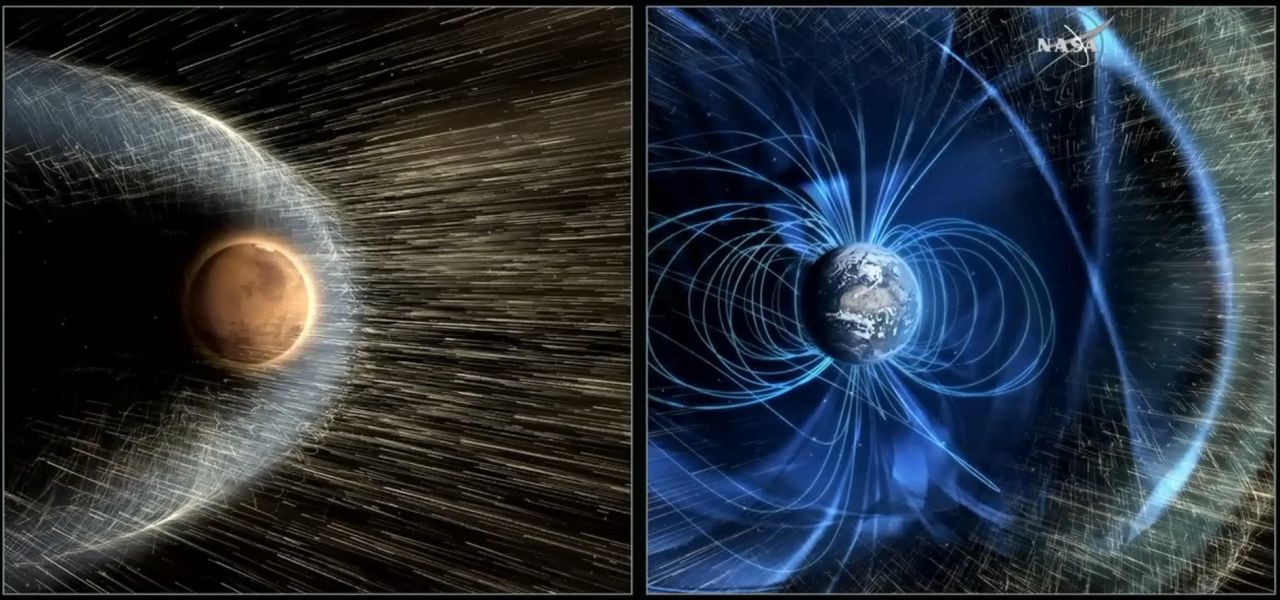How Mars lost its atmosphere and became a cold, dry world
A NASA spacecraft orbiting Mars spies solar storms blowing Martian atmosphere away.
Artist’s rendering of a solar storm hitting Mars and stripping ions from the planet's upper atmosphere.
NASA/GSFC
Although the planet’s atmosphere is presently losing about 100 grams per second—the equivalent of a McDonald’s Quarter Pounder—scientists say Mars lost the bulk of its once thick atmosphere billions of years ago, a relatively short time after our solar system formed. The findings were published in multiple articles Thursday in Science and Geophysical Research Letters.
Mars once had a strong magnetic field—like Earth does now—produced by a dynamo effect from its interior heat. But as the smaller planet cooled, Mars lost its magnetic field some time around 4.2 billion years ago, scientists say. During the next several hundred million years, the Sun’s powerful
At that time Mars would have lost about the same amount of atmosphere that Earth has today, with its surface pressure of about 1,000 millibars. During that relatively short epoch the lakes and rivers on Mars, of which geologic evidence remains today, would have frozen and evaporated. The consequences for any life that might have existed almost certainly would have been disastrous. Today, billions of years later, the dry, red world has a surface pressure of only about 6 millibars.
Before the MAVEN spacecraft entered orbit around Mars in September of 2014, planetary scientists had different theories about how Mars had lost its atmosphere. The solar wind was a leading candidate. There were also ideas that perhaps much of the carbon dioxide and oxygen had been trapped by Martian rocks, or asteroids and comets had knocked it into space.
However, the new data, collected during many orbits in which MAVEN dipped in and out of the Martian upper atmosphere, clearly implicates the solar wind. A stream of mainly protons and electrons that flows from the Sun, the solar wind produces an

Enlarge / Without a strong magnetic field like Earth, Mars is laid bare to solar storms.
NASA
In addition to the “normal” solar wind, MAVEN had the opportunity to observe the effect of several solar storms in March, which led to a much more dramatic loss of atmosphere when the escape rate of particles increased by 10 to 20 times. “This is exciting, because solar storms were more common and intense in solar system history,” said Dave Brain, a MAVEN scientist at the University of Colorado, during a news conference Thursday.
That implies that just as Mars was losing its magnetic field about 4 billion years ago, its unprotected atmosphere would have been exposed to much more intense and frequent solar storms than occur today.
MAVEN will complete its primary mission on November 16 and then continue into extended duty. During many orbits in the last year it flew within 125 km of the surface before swooping back out to more than 6,000 km away to observe the entire planet.
The new findings should have little effect on NASA’s efforts to send humans to Mars. Under current iterations of its Mars plans, NASA intends to harvest carbon dioxide in the atmosphere as a resource to potentially produce rocket fuel and oxygen. But there’s no rush. Thin as the Martian atmosphere may be, at its current rate of loss scientists estimate the
However, finding proof that the solar wind has stripped away the Martian atmosphere bodes poorly for speculative plans to terraform Mars. There had been some hope that considerable chunks of the ancient Martian atmosphere might be locked away in and beneath its surface. If released by heat, the theory went, carbon dioxide released from rocks could thicken the Martian atmosphere.
Alas, after the old Martian atmosphere left, scientists now understand it was carried away by the solar wind, gone forever. Additionally, absent a strong magnetic field, it would be difficult
No comments:
Post a Comment